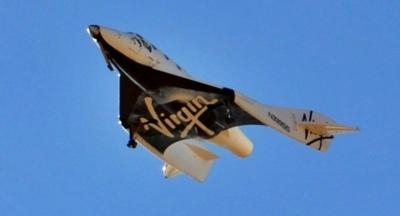Sat, Jun 30, 2012
Company On Track For First Powered Flight By End Of Year
SpaceShipTwo (SS2) is two steps closer to making its first powered flight, after the suborbital space vehicle successfully completed its first glide flight test since a recent integration period for rocket motor systems and maintenance, and the spaceship’s engine, RocketMotorTwo (RM2), underwent another successful full duration test fire ... on the same day.

June 26th marked the first time the company and its partners have undertaken test flight and test firing on the same day. Both milestones prime Virgin Galactic to reach powered flight by the end of the year.
“Since receiving an experimental launch permit from the Federal Aviation Administration in May for SpaceShipTwo and its carrier vehicle, WhiteKnightTwo, there has been a rapid escalation of test activity,” said George Whitesides, CEO and president of Virgin Galactic. “In that timeframe, we’ve had seven successful test flights and three full-scale rocket motor tests. We are on track for powered flight by the end of 2012.”
The glide flight was performed by Scaled Composites, the prime contractor for the spaceflight system. To perform the flight, SS2 was air-released from WhiteKnightTwo (WK2) at an altitude of 51,000 feet. At the SS2 controls were Scaled pilots Pete Siebold and Mike Alsbury. In the carrier aircraft were Scaled test pilot Mark Stucky and David Mackay, Virgin Galactic’s Chief Pilot. Flying in the chase plane for the test were Mike Melvill, who piloted the first private flight to space, and Virgin Galactic pilot Keith Colmer.
The rocket motor firing was performed by Sierra Nevada Space Systems, the prime contractor for the RM2 system. The 55-second test was the thirteenth full-scale flight design RM2 hot fire. All objectives were completed. In addition to this test, on June 20 a full-scale RM2 test firing took place for the first time at Scaled Composites’ test site in Mojave, Calif., under full direction of the spaceship’s Rocket Motor Controller. This firing provided an end-to-end test of the rocket motor systems – a critical step in preparation for powered flight.
(Image provided by Virgin Galactic)
More News
He Attempted To Restart The Engine Three Times. On The Third Restart Attempt, He Noticed That Flames Were Coming Out From The Right Wing Near The Fuel Cap Analysis: The pilot repor>[...]
Make Sure You NEVER Miss A New Story From Aero-News Network Do you ever feel like you never see posts from a certain person or page on Facebook or Instagram? Here’s how you c>[...]
From 2009 (YouTube Edition): Leading Air Show Performers Give Their Best Advice for Newcomers On December 6th through December 9th, the Paris Las Vegas Hotel hosted over 1,500 air >[...]
Aero Linx: NASA ASRS ASRS captures confidential reports, analyzes the resulting aviation safety data, and disseminates vital information to the aviation community. The ASRS is an i>[...]
“For our inaugural Pylon Racing Seminar in Roswell, we were thrilled to certify 60 pilots across our six closed-course pylon race classes. Not only did this year’s PRS >[...]
 NTSB Final Report: Rutan Long-EZ
NTSB Final Report: Rutan Long-EZ ANN FAQ: Turn On Post Notifications
ANN FAQ: Turn On Post Notifications Classic Aero-TV: ICAS Perspectives - Advice for New Air Show Performers
Classic Aero-TV: ICAS Perspectives - Advice for New Air Show Performers ANN's Daily Aero-Linx (06.28.25)
ANN's Daily Aero-Linx (06.28.25) Aero-News: Quote of the Day (06.28.25)
Aero-News: Quote of the Day (06.28.25)



